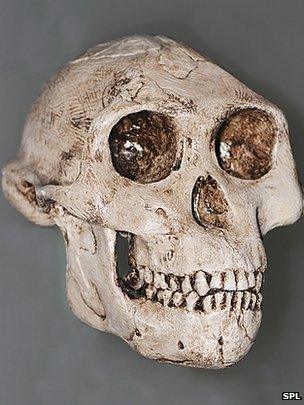Human ancestors' diet changed 3.5 million years ago
- Published

Australopithecus afarensis (pictured in an artist's impression) had different diets from their ancestors
A new analysis of early human teeth from extinct fossils has found that they expanded their diets about 3.5 million years ago to include grasses and possibly animals.
Before this, humanlike creatures - or hominins - ate a forest-based diet similar to modern gorillas and chimps.
Researchers analysed fossilised tooth enamel of 11 species of hominins and other primates found in East Africa.
The findings appear in four papers published in PNAS journal.
Like chimpanzees today, many of our early human ancestors lived in forests and ate a diet of leaves and fruits from trees, shrubs and herbs.
But scientists have now found that this changed 3.5 million years ago in the species Australopithecus afarensis and Kenyanthropus platyops.
Their diet included grasses, sedges, and possibly animals that ate such plants. They also tended to live in the open savannahs of Africa.
The new studies show that they not only lived there, but began to consume progressively more foods from the savannahs.
Researchers looked at samples from 175 hominins of 11 species, ranging from 1.4 to 4.1 million years old.
Their diet was analysed from the chemical make up of their teeth, identifying the carbon isotopes within them.
The ratios of different types of carbon atoms, or isotopes, in fossils can give clues to what a fossil creature ate because different foods have different carbon isotope signatures.
"What we have is chemical information on what our ancestors ate, which in simpler terms is like a piece of food item stuck between their teeth and preserved for millions of years," said Dr Zeresenay Alemseged, from the California Academy of Sciences, co-author on two of the papers.
"Because feeding is the most important factor determining an organism's physiology, behaviour and its interaction with the environment, these finds will give us new insight into the evolutionary mechanisms that shaped our evolution."
It is not yet clear whether the change in diet included animals, but "the possible diets of some of our hominin kin" has been considerably narrowed down, Dr Matt Sponheimer, lead author of another of the papers, external, told BBC News.
A new habitat
"We now have good evidence that some early hominins began using plant foods that are not used in abundance by living African apes today, and this probably led to a major change in the way they used the landscape.
"One consequence could be that the dietary expansion led to a habitat expansion, as they could travel to more open habitats more efficiently.
"We know that many early hominins lived in areas that would not have readily supported chimpanzees with their strong preference for forest fruits. It could also be argued that this dietary expansion was a key element in hominin diversification."
The study has also answered, at least in part, what researchers have long been speculating - how so many large species of primate managed to co-exist.

The teeth of fossils 3.5 million years old give scientists clues to their diet
"They were not competing for the same foods," said Prof Thure Cerling from the University of Utah, who led one of the research papers., external
'The modern human'
"All these species who were once in the human lineage, ventured out into this new world of foods 3.5 million years ago, but we don't yet understand why that is."
As well as looking at non-human primates, the researchers analysed fossils from other animals from the same era and did not find any evidence of a change in diet.
This combined research highlights a "step towards becoming the modern human", said Dr Jonathan Wynn from the University of South Florida, who led the analysis of Australopithecus afarensis, external.
"Exploring new environments and testing new foods, ultimately might be correlated with further changes in human history."
These four complementary studies give a persuasive account of shifts in dietary niche in East African hominins, Dr Louise Humphrey from the Natural History Museum in London, told BBC news.
- Published27 June 2012
- Published11 August 2010